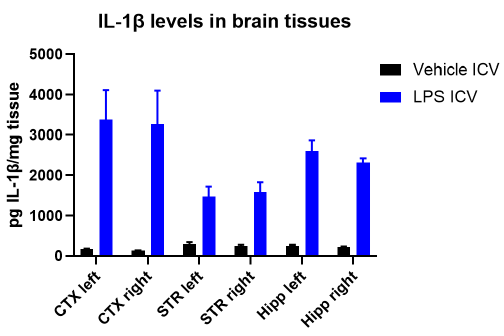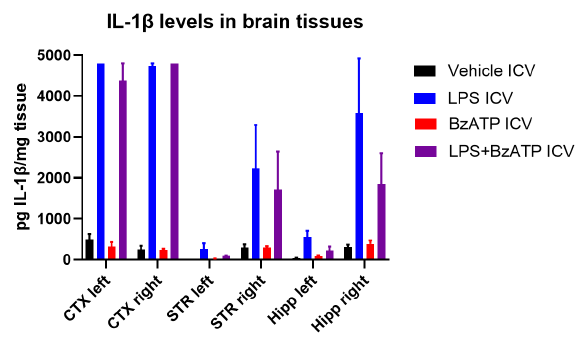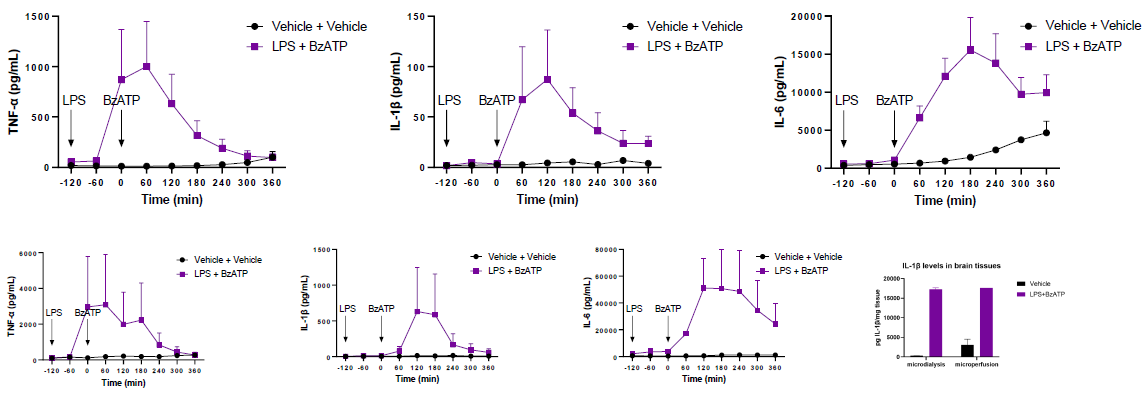This article is based on a poster originally authored by M.S. Heins, S. Hatusupy, M.F. Olthuis, and presented at SfN 2024.
Neuroinflammation contributes to numerous neurodegenerative diseases. The blood-brain barrier (BBB) maintains an immune-privileged condition in the brain, making peripherally-produced inflammation unsuitable for investigating neuroinflammation.
Peripheral inflammation can cross over to the central nervous system by affecting the BBB’s integrity, transporting inflammatory cells and cytokines from the bloodstream to the brain. A more representative model would show local neuroinflammation in the brain with no peripheral effects.
This study explores the best experimental design for a locally produced neuroinflammation model in adult male C57Bl/6J mice utilizing three stimuli (LPS, BzATP, and LPS+BzATP).
Pro-inflammatory cytokine levels were measured in various tissues and fluids, including interstitial fluid collected via push-pull microdialysis or open-flow microperfusion, and blood and brain tissue were analyzed.
The differential distribution and localization of pro-inflammatory cytokines responding to various stimuli were studied.
Methods
The studies were conducted in an AAALAC-accredited laboratory following the National Research Council's Guide for the Care and Use of Laboratory Animals (2011) and the European Union’s Directive 2010/63 standards. The Netherlands’ national animal experimentation commission approved all animal treatments.
A comparison was first made between acute intracerebroventricular (ICV) administration of LPS in anesthetized animals vs ICV administration of LPS and/or BzATP following cannulation surgery and recovery in freely moving awake animals. Terminal brain tissues were harvested four hours post-dose and analyzed using IL-1β ELISA (R&D Systems).
The timing of LPS and BzATP administration could then be examined. Adult male C57Bl/6J mice were surgically cannulated at the left ICV for administration and the right CTX for microdialysate or microperfusate collection.
Following recovery, the awake and freely moving animals were treated, and microdialysate or microperfusate samples were taken.
All obtained samples were analyzed using IL-1β ELISA (R&D Systems) or a mouse inflammatory panel, specifically for TNF-α, IL-1β, and IL-6 levels (MSD). Only data from the most recent trial with optimal timing is presented here.
Tissue levels 4h after ICV administration
Acute ICV delivery of LPS (blue bars) to anesthetized adult male C57Bl/6J mice followed by terminal tissue collection four hours post-dose shows strong IL-1β elevations throughout the brain, but this is not detected in vehicle-administered animals (black bars). Blood and CSF IL-1β levels for the vehicle-administered animals were below the limit of quantification (LLOQ). LPS-treated rats significantly increased IL-1β levels in CSF (~2200 pg/mL) but only moderately increased plasma (~100 pg/mL).

Acute ICV administration. Image Credit: Charles River Laboratories
ICV injection of LPS (blue bars), BzATP (red bars), or LPS + BzATP (purple bars) in freely moving cannulated adult male C57Bl/6J mice followed by terminal tissue collection at four hours post-dose showed significant increases in IL-1β for the LPS and the LPS + BzATP administered animals. This was not observed in BzATP or vehicle (black bars) administered animals. The effects were stronger in the left and right cortices than in the striatum and hippocampal tissues. The vehicle-administered animals had IL-1β levels below LLOQ, while the LPS + BzATP-dosed mice had a small plasma rise (~60 pg/mL).

Cannulated freely-moving ICV administration. Image Credit: Charles River Laboratories.
Microdialysis after ICV administration
ICV administration of LPS at t = 120 minutes, followed by BzATP at t = 0 minutes (purple squares), increased TNF-α, IL-1β, and IL-6 levels in the brain cortical interstitial space. Vehicle-treated animals (black circles) did not show any immediate increase.
Following BzATP ICV delivery, TNF-α, IL-1β, and IL-6 levels increased significantly compared to vehicle controls.
These findings were obtained in both push-pull microdialysates and open-flow microperfusates; however, the push-pull microdialysates (upper graphs) appeared less variable than the open-flow microperfusates (bottom graph).
The IL-1β levels in terminal tissue samples were consistent with interstitial fluid levels and previous tissue collection experiments. LPS + BzATP-administered animals showed a significant increase in IL-1β levels (purple bars), while vehicle-administered animals showed no or low levels (black bars).
Optimizing the timing of LPS and BzATP stimulation resulted in elevated levels of inflammatory cytokines TNF-α, IL-1β, and IL-6 in mouse brain interstitial fluids.
These could be identified using both push-pull microdialysis and open-flow microperfusion. Based on these experimental findings, push-pull microdialysis is recommended over open-flow microperfusion since the microdialysis results are more consistent.
Locally applied LPS combined with microanalysis reduces the peripheral side effects of neuroinflammation and enables the study of potential time-dependent effects of anti-neuroinflammatory drugs.

Image Credit: Charles River Laboratories.

Image Credit: Charles River Laboratories.
About Charles River Laboratories
At Charles River, we are passionate about our role in improving the quality of people’s lives. Our mission, our excellent science and our strong sense of purpose guides us in all that we do, and we approach each day with the knowledge that our work helps to improve the health and well-being of many across the globe.
Charles River provides essential products and services to help pharmaceutical and biotechnology companies, government agencies and leading academic institutions around the globe accelerate their research and drug development efforts.
As a fully integrated partner, Charles River can support your research at any point along the drug discovery continuum.
Sponsored Content Policy: News-Medical.net publishes articles and related content that may be derived from sources where we have existing commercial relationships, provided such content adds value to the core editorial ethos of News-Medical.Net which is to educate and inform site visitors interested in medical research, science, medical devices and treatments.